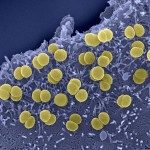Link to Pubmed [PMID] – 26858137
Link to DOI – 10.1111/mmi.13349
Mol Microbiol 2016 06; 100(5): 788-807
The bacterial phosphotransferase system (PTS) transports and phosphorylates sugars, but also carries out numerous regulatory functions. The β-proteobacterium Neisseria meningitidis possesses an incomplete PTS unable to transport carbon sources because it lacks a membrane component. Nevertheless, the residual phosphorylation cascade is functional and the meningococcal PTS was therefore expected to carry out regulatory roles. Interestingly, a ΔptsH mutant (lacks the PTS protein HPr) exhibited reduced virulence in mice and after intraperitoneal challenge it was rapidly cleared from the bloodstream of BALB/c mice. The rapid clearance correlates with lower capsular polysaccharide production by the ΔptsH mutant, which is probably also responsible for its increased adhesion to Hec-1-B epithelial cells. In addition, compared to the wild-type strain more apoptotic cells were detected when Hec-1-B cells were infected with the ΔptsH strain. Coimmunoprecipitation revealed an interaction of HPr and P-Ser-HPr with the LysR type transcription regulator CrgA, which among others controls its own expression. Moreover, ptsH deletion caused increased expression of a ΦcrgA-lacZ fusion. Finally, the presence of HPr or phospho-HPr’s during electrophoretic mobility shift assays enhanced the affinity of CrgA for its target sites preceding crgA and pilE, but HPr did not promote CrgA binding to the sia and pilC1 promoter regions.

